Climate Change Plan: monitoring report 2019
Second annual report monitoring progress towards Scotland's 2018 Climate Change Plan.
Electricity
Greenhouse gas emissions from the electricity sector have already been reduced by 92% (1990 to 2017).
The Plan sets out the following two policy outcomes for the sector:
1. From 2020 onwards, Scotland’s electricity grid intensity will be below 50 grams of carbon dioxide per kilowatt hour. The system will be powered by a high penetration of renewables, aided by a range of flexible and responsive technologies.
2. Scotland’s energy supply is secure and flexible, with a system robust against fluctuations and interruptions to supply.
Scotland’s energy system continues to evolve and is making the transition from a traditional centralised model, reliant on fossil fuels, to a decentralised model, with a more diverse electricity generation mix incorporating large volumes of renewable and other low carbon sources of electricity.
Latest figures show Scotland has already reached the target of having an electricity grid intensity below 50 gCO2 per kilowatt hour, with the 2017 figure showing a grid intensity of 24 gCO2/kWh, a fall of 56% since 2016.
Renewable electricity generation capacity in Scotland has more than trebled in the last ten years; as of June 2019, there was 11.6 GW of installed capacity across the country. Consequently, renewables’ contribution towards the total volume of electricity generated has grown from 18.5% in 2008 to 51.7% in 2017.
There is also currently an additional 13.0 GW of renewables capacity either under construction or at the planning stage, the majority of which is from wind generation. This indicates a strong pipeline, and a substantial level of capacity which could be added to the system in the future.
Output Indicator For Policy Outcome 1:
For the duration of the Plan, Scotland’s electricity grid intensity will be below 50 gCO2 per kilowatt hour, powered by a high penetration of renewable technologies, including onshore wind, offshore wind, island wind, hydro, solar, marine and bioenergy.
Most Recent Data: Grid intensity of 24.0 gCO2 per kilowatt hour in 2017.
Data Source(s): Scottish Government Energy Statistics Database[1].
On Track: Yes.
Commentary:
- Grid intensity of Scotland dropped from 54.9 gCO2/kWh in 2016 to 24.0 gCO2/kWh in 2017, below 50 gCO2/kWh for the first time.
- This fall continues the downward trend from a carbon intensity of 320 gCO2e/kWh in 2010, chiefly the result of the closure of Cockenzie and Longannet coal fired power stations in 2013 and 2016, as well as a reduced reliance on gas for power generation. This has significantly reduced the use of fossil fuels for electricity generation, resulting in a large reduction in emissions from power generation in Scotland.
- The reduction in electricity generation from coal and gas fired power stations over the last ten years has been partially offset by an increase in generation from lower carbon sources. This includes nuclear power, but most notably comes from renewable generation, which now makes up over 50% of our electricity share.
Electricity Figure 1: Grid Intensity per kWh
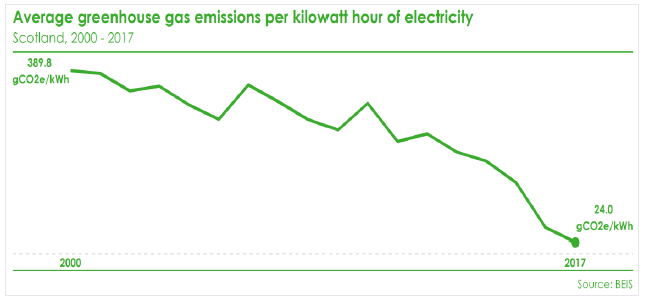
Output Indicator For Policy Outcome 2:
Scotland’s energy supply is secure and flexible, with a system robust against fluctuations and interruptions to supply.
Most Recent Data: Scotland’s electricity and gas supply remains secure. Peak electricity demand in Scotland for winter 2018/19 was 5.3 GW. This is within Scotland’s maximum supply capacity from non-intermittent sources, which was 10.0 GW.
Data Source(s): Scottish Government Energy Statistics Database[1].
On Track: Yes.
Commentary:
- In Electricity Figure 2, the supply capacity is defined as including dispatchable generation in Scotland (gas, nuclear, hydro and pumped storage) plus the secure import capability from Ireland over the Moyle interconnector, and over the GB transmission system from England and Wales.
- Scotland’s electricity system has remained secure in each year in terms of having confidence that we can meet peak demand. Even though Scotland’s maximum supply capacity is lower since the closure of Longannet in 2016 there has still been sufficient capacity to cope with peak demand.
- It should be noted that Scotland’s wind and solar generation capacity is not included due to its intermittent nature.
- Scottish generation represents approximately 5.6 GW of the maximum supply capacity; the remainder consists of the Moyle Interconnector (500 MW) and other secure imports.
- As detailed in our Electricity and Gas Networks: Vision to 20302, the Scottish Government will continue to engage with network operators and owners, as well as with Ofgem and the UK Government, to ensure that network investment, innovation and regulation remains sufficient to ensure a secure and resilient transmission network, with stronger interconnectors between Scotland and Europe.
Electricity Figure 2: Maximum supply capacity and peak electricity demand 2010/11-2018/19
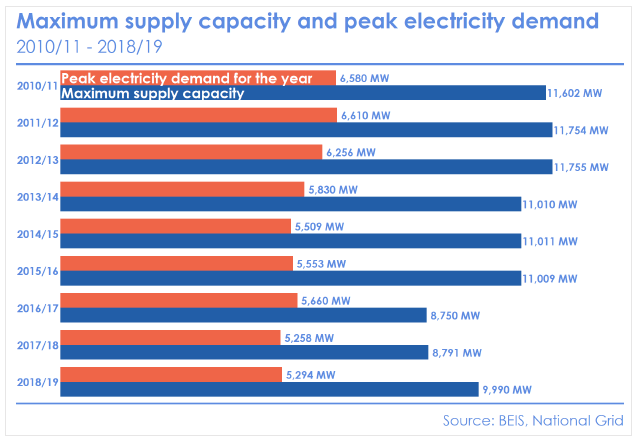
Implementation Indicator For Policy Outcomes 1 And 2:
Increase amount of electricity generated from renewable sources in Scotland.
Most Recent Data: 26,473 GWh of renewable electricity generated in 2018.
Annual Change: 1,482 GWh increase in electricity generated from renewable sources from 2017 to 2018.
Data Source(s): BEIS Energy Trends[3].
Commentary:
- Electricity Figure 3 below shows the levels of electricity generation from renewable sources in Scotland from 2011-2018.
- In 2018, renewable electricity increased 6% on 2017 levels, 2017 having previously been a record breaking year for renewable generation.
- This increase is due to a continued increase in generation from onshore wind. Scotland’s wind energy sector saw a record-breaking 2018. In the last year there was a 0.97 GW increase in wind capacity, from both onshore and offshore sources.
Electricity Figure 3: Electricity generated (GWh) from renewable sources, Scotland, 2011-2018
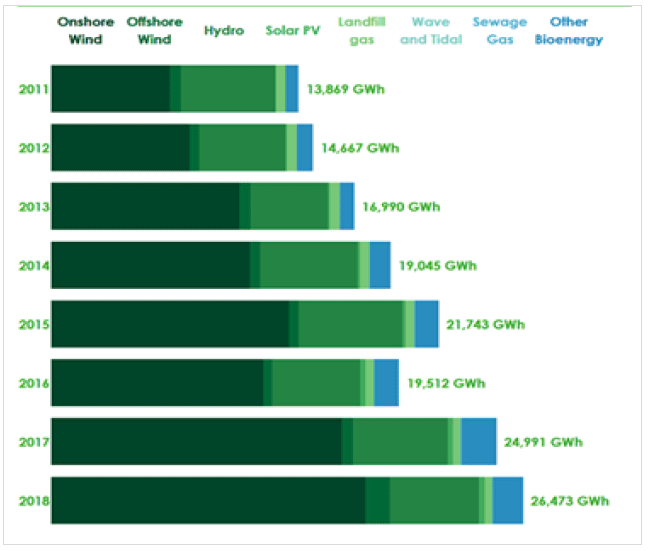
Implementation Indicator For Policy Outcomes 1 And 2:
Increase the installed capacity of sites generating electricity from renewable sources in Scotland. By 2030, it is expected that the installed capacity of renewable electricity generation sources will be between 12GW and 17GW.
Most Recent Data: 11.6 GW of installed capacity at end of June 2019.
Previous Year: 10.5GW of installed capacity at end June 2018.
Change: 1.1 GW increase in installed capacity from June 2018 to June 2019.
Data Source(s): BEIS Energy Trends[3].
Commentary:
- Installed capacity of renewable generation increased from 10.5 GW to 11.6 GW (10%) between the end of June 2018 and June 2019.
- Operational renewable electricity capacity continues to rise, and as of June 2019 there is 13.0 GW of capacity in the pipeline (albeit not all of these projects will progress to commissioning). 9.1 GW of the current installed capacity is from wind, with offshore wind growing rapidly, primarily due to the Beatrice wind farm becoming operational.
- Although there is a significant number and capacity of renewable projects in the planning pipeline, it is anticipated that recent changes to subsidy schemes for large and small scale renewables will have an impact on the rate at which additional projects will become operational, most notable the closure by the UK Government of the Feed in Tariff to new applicants on 31 March 2019.
Implementation Indicator For Policy Outcomes 1 And 2:
Increase total community and locally owned renewable energy capacity operational, and in development, in Scotland.
Most Recent Data: 697 MW of community and locally owned renewable energy capacity in June 2018.
Previous Year: 655 MW of community and locally owned renewable energy capacity in June 2017.
Change: 42 MW increase in community and locally owned renewable energy capacity from June 2017 to June 2018.
Data Source(s): EST Community Energy Report (June 2018)[4].
Commentary:
- An estimated 697 MW of community and locally owned renewable energy capacity was operational in Scotland.
- This is a 6% increase on the operational capacity at June 2017 of 655 MW (this is a revision to the 666 MW reported in the 2018 Climate Change Plan monitoring report).
- The Scottish Government has targets of 1 GW of community and locally owned energy by 2020 and 2 GW by 2030. The estimated operating capacity of 697 MW was 70% and 35%, respectively, towards these new targets.
- The operating capacity resulted from a total of around 18,830 individual renewable energy installations.
Electricity Figure 4: Community and locally owned renewable energy capacity in different stages of development (MW), Scotland, June 2018

Implementation Indicator For Policy Outcomes 1 And 2:
Increase total renewable capacity in Scotland by planning stage.
Most Recent Information: As of June 2019, renewable electricity projects with a capacity of 13.0 GW are in the pipeline, that is consented projects that are in planning, awaiting construction or under construction.
Information Source(s): Scottish Government Energy Statistics Database[1].
Commentary:
- As of June 2019 there is 13.0 GW of consented renewable electricity projects in the pipeline. This is greater than the 11.6 GW of renewable electricity currently deployed in Scotland.
- Onshore and offshore wind make up over 90% of the capacity in the pipeline, with 1.1 GW under construction and a further 10.9 GW awaiting construction or in planning. Shoreline wave and tidal is the next largest technology, with 0.38 GW awaiting construction or in planning. There is currently 0.02 GW of this technology operational in Scotland.
- If all consented pipeline projects become operational, it is estimated that this could generate approximately 31,500 GWh of renewable electricity annually. However, it is worth noting that it is unlikely that all projects consented in the pipeline will progress to commissioning, and that grid intensity and renewable electricity ambitions remain challenging.
Electricity Figure 5: Renewable Capacity in Scotland by Planning Stage, March 2019
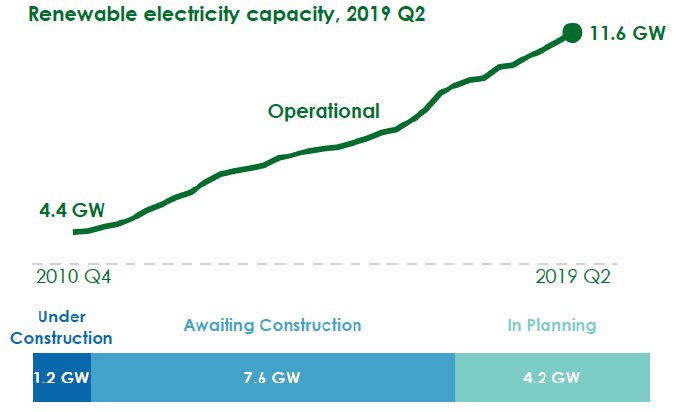
Implementation Indicator For Policy Outcomes 1 And 2:
Increase the share of electricity generated from renewable sources, as a proportion of total electricity generated in Scotland.
Most Recent Data: 51.7% of electricity generated from renewable sources in 2017.
Previous Year: 42.8% of all electricity generated in Scotland came from renewable sources in 2016.
Change: 8.9 percentage point increase in proportion of electricity generated from renewable sources from 2016 to 2017.
Data Source(s): Scottish Government Energy Statistics Database1.
Commentary:
- Renewable electricity generation in 2017 was 29% higher than 2016 levels, with an overall increase of almost 5,600 GWh. As a result of this, the share of renewables as a proportion of total electricity generated in Scotland increased to 51.7%.
- The largest increase in renewable generation came from wind power, which increased by over 4,500 GWh and makes up almost 35% of total electricity generation alone.
- The total low carbon electricity generation in Scotland is 88% of total electricity generation, compared to 44% in England and Wales.
Electricity Figure 6: Share of Electricity Generated (GWh) by Renewables, 2004 - 2017
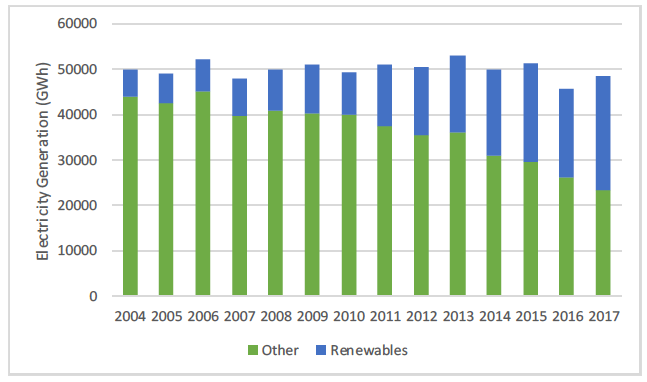
Contact
Email: climate.change@gov.scot
There is a problem
Thanks for your feedback